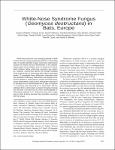White-Nose Syndrome Fungus (Geomyces destructans) in Bats, Europe
Wibbelt, Gudrun
Kurth, Andreas
Hellmann, David
Weishaar, Manfred
Barlow, Alex
Veith, Michael
Prüger, Julia
Görföl, Tamás
Grosche, Lena
Bontadina, Fabio
Zöphel, Ulrich
Seidl, Hans-Peter
Cryan, Paul M.
Blehert, David S.
White-nose syndrome is an emerging disease in North America that has caused substantial declines in hibernating bats. A recently identified fungus (Geomyces destructans) causes skin lesions that are characteristic of this disease. Typical signs of this infection were not observed in bats in North America before white-nose syndrome was detected. However, unconfirmed reports from Europe indicated white fungal growth on hibernating bats without associated deaths. To investigate these differences, hibernating bats were sampled in Germany, Switzerland, and Hungary to determine whether G. destructans is present in Europe. Microscopic observations, fungal culture, and genetic analyses of 43 samples from 23 bats indicated that 21 bats of 5 species in 3 countries were colonized by G. destructans. We hypothesize that G. destructans is present throughout Europe and that bats in Europe may be more immunologically or behaviorally resistant to G. destructans than their congeners in North America because they potentially coevolved with the fungus.
Dateien zu dieser Publikation
Keine Lizenzangabe

